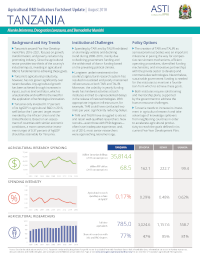Authors:
Nienke Beintema, Deogratias Lwezaura, and Bernadetha Munishi
Year:
2018
Publisher
International Food Policy Research Institute and Department of Research and Development
Back to:
Background and key trends
- Tanzania’s second Five Year Development Plan, 2016–2021, focuses on growth, transformation, and poverty reduction by promoting industry. Since the agricultural sector provides two-thirds of the country’s industrial inputs, investing in agricultural R&D is fundamental to achieving these goals.
- Tanzania’s agricultural productivity, however, has not grown significantly over recent decades. Any agricultural growth has been achieved through growth in inputs, such as land and labor, which is unsustainable and reaffirms the need for the application of technological innovation.
- Tanzania only invested 0.17 percent of its AgGDP in agricultural R&D in 2016, well below the 1 percent target recommended by the African Union and the United Nations. A more conservative target based on an assessment of African countries with similar economic conditions indicates that Tanzania could have invested 0.46 percent of its AgGDP—still significantly more than its actual level.
Institutional challenges
- Spending by TARI (and its predecessor DRD) and by TALIRI exhibited an alarmingly volatile and declining trend during 2000‒2016, mainly due to declining government funding and the withdrawal of donor funding in based on the prevailing political climate.
- Longterm underinvestment in the country’s agricultural research system has resulted in outdated and poorly maintained infrastructure at both TARI and TALIRI. Furthermore, the volatility in yearly funding levels has hampered operations and research activities at both institutes.
- TARI and TALIRI have struggled to attract and retain well-qualified researchers. New recruits—even those with PhD degrees—had inadequate experience, and, as of 2016, most senior researchers were approaching retirement age.
Policy options
- The creation of TARI and TALIRI as semiautonomous bodies was an important milestone in paving the way for competitive recruitment mechanisms, efficient operating procedures, diversified funding mechanisms, and innovative partnerships with the private sector to develop and commercialize technologies. Nevertheless, sustainable government funding is needed for the institutes to maintain a foundation from which to achieve these goals.
- Both institutes require solid training and mentorship plans, supported by the government to address the human resource challenges.
- Tanzania needs to increase its investment in agricultural research and take advantage of knowledge spillovers from neighboring countries in order to accelerate agricultural productivity to reach the goals defined in its current Five-Year Development Plan.

